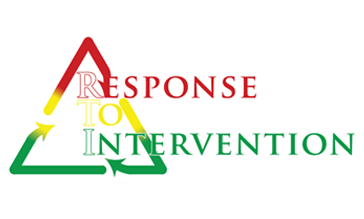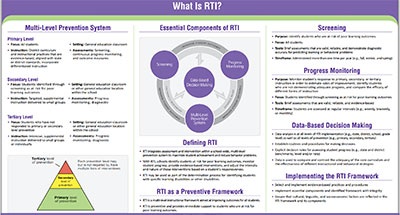BEST Practice #2:
Response to Intervention (RtI)

Response to Intervention (RtI)
Response to Intervention (RtI) is a process that uses student academic and behavior information to identify students with learning and behavior needs to guarantee that those in danger of failure and/or retention are receiving assistance and support. The RtI process uses a team approach to develop individual academic and behavior plans; keep track of student progress; provide assistance using academic and behavior strategies that have been proven to work; and identify students with disabilities. A team of educational professionals and the parents work together to develop individual plans for children's academic success. This process provides students with academic, social, emotional, and community support.
The RtI process uses screening, monitoring, academic and behavior support, and student information to provide the best possible interventions for student success.
Screening:
Information like grades, attendance, and behavior records are used by educators to identify students who may be at risk of failure and/or retention. Parents of children experiencing academic difficulties are encouraged to contact their child's school for assistance.
Progress monitoring:
Progress monitoring is the process used to keep track of the success of the interventions provided to students through a multi-level system.
Multi-level prevention system:
RtI includes three levels of support that increase in intensity based on the needs of the student. Level 1 is the Primary Prevention level which includes high-quality teaching. Level 2 is the Secondary Prevention level which uses academic and behavior strategies that have been proven to work. Level 3 is the Tertiary Prevention level which develops unique individual strategies for students in need of additional assistance.
Primary Prevention: Level 1
In Level 1 minor changes are made to the existing curriculum and teaching practices. Students are monitored for progress.
Secondary prevention: Level 2
Students who do not respond to Level 1 interventions are provided additional support such as small-group instruction and individualized attention. Academic and behavioral strategies that have proven results are also used to support student progress.
Tertiary prevention: Level 3
Level 3 of the RtI process is the most intensive of the three levels and targets each student's needs. At this level, interventions may include smaller groups with longer and more frequent sessions. Other creative strategies may also be used to meet the unique needs of the students.
Data-based decision making:
Student information is used to make decisions about instruction, movement within the RtI process, and to identify student disabilities in accordance with state law.
BEST Practice #2 RtI Resources:
www.browardprevention.org/response-to-intervention/
http://app.brainshark.com/browardschools/rtiparentfocus?&r3f1
RtI Process:
The BEST Blueprint & AdvancED Accreditation Standards Correlation:
Standard 1 - Purpose and Direction:
The RtI process emphasizes and reinforces BCPS’ commitment to student success.The process allows for progressive interventions to help students to achieve.Through RtIs educators and community members are able to initiate, implement and communicate a continuous improvement process for improving conditions that support student learning.
Standard 2 - Governance and Leadership:
The RtI process is communicated and supported through the Office of Academics, where a team of educators and administrators provide training, resources and professional development to ensure that leadership and staff are able to meet and exceed student achievement goals. RtI also engages and empowers stakeholders to initiate communication with school personnel to increase student achievement.
Standard 3 - Teaching and Assessing for Learning:
RtI is a responsive process that allows for increased supports, customized learning experiences and interventions for students in danger of failing. Educators and administrators are charged with creating and monitoring instructional strategies to ensure that students within the RtI process are on track for achievement. Educators receive coaching, mentorship and professional development to ensure they are able to respond to individualized learning needs within their classrooms. The process encourages parent engagement and creates a partnership between parents and educators to ensure the success of children individually and collectively.
Standard 4 - Resources and Support Systems:
PLC’s are part of the district’s systematic process for retaining qualified educators to fulfill their roles and responsibilities and support the purpose and direction of the district, their respective schools and county-wide educational programs. PLC’s are customized and utilize various resources made available through the district. Technology infrastructure and material resources support the PLC process by developing teachers’ skills to ensure success for all students.
Standard 5 - Using Results for Continuous Improvement:
The RtI process is initiated in response to student achievement data including standardized tests and assessments. Students have a cumulative and accessible academic and behavioral record allowing educators to look at student performance in a comprehensive manner. Educators and leaders are trained to review these data and work with students and parents to establish plans and activities to help increase student learning and subsequent achievement. The process also supports adjustments in instructional strategies to ensure verifiable improvements in student learning, including readiness for and success at the next level.


